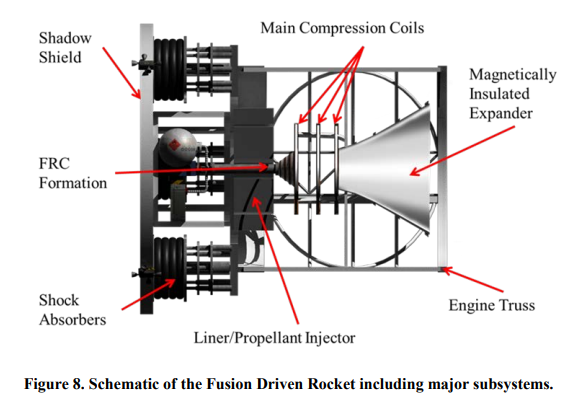Proxima Centauri b is the closest known exoplanet that could be in the habitable zone of its star. Therefore, it has garnered a lot of attention, including several missions designed to visit it and send back information. Unfortunately, due to technological constraints and the gigantic distances involved, most of those missions only weigh a few grams and require massive solar scales or pushing lasers to get anywhere near their target. But why let modern technological levels limit your imagination when there are so many other options, if still theoretical, options to send a larger mission to our nearest potentially habitable neighbor? That was the thought behind the Master’s Thesis of Amelie Lutz at Virginia Tech – she looked at the possibility of using fusion propulsion systems to send a few hundred kilogram probe to the system, and potentially even orbit it.
Since Proxima Centauri b is potentially habitable, there are a lot of different sensors that scientists would like to take to it to monitor it closely. Ms. Lutz details 11 sensors that would go on the craft, including spectrometers, magnetometers, and imaging and sounding systems that would allow it to peer beneath the planet’s ice sheets (if there are any).
In addition, there would be a high power communications array. However, getting a signal back from another star is difficult to say the least. Ms. Lutz proposes using the solar gravitational lens of Proxima Centauri itself to pump up the communication power and bandwidth to a respectable 10 Mb per second per watt of power devoted to the communications array.
Fraser discusses how fusion rockets could take us to other stars.
Where that power comes from is the real crux of the thesis though – the spacecraft would rely on a fusion generator both for its propulsion and for its electrical power. Ms. Lutz looked at three different types of fusion drives, each of which could use four different types of fuel.
First is a fusion driven rocket, which directly converts the energy created by the fusion reaction into thrust using a technique called magneto-inertial fusion. Next up is a inertial-electrostatic confinement engine, which is small and lightweight but suffers from technical challenges that limit its potential power output. Another potential drive system is an Antimatter Initiated Microfusion (AIM) system, which is the smallest system, but requires antimatter to get started, which is extraordinarily rare and expensive.
The four different types of fuels are those typically considered when discussing fusion reactions, either for commercial power generation or spacecraft propulsion. Deuterium-Deuterium (D-D) reactions are the simplest, but suffer from low energy output. Deuterium-Tritium (D-T) has a higher energy, but creates lots of neutrons that could potentially rip through a spacecraft’s shielding and destroy its internal systems. Proton-Boron-11 (p-B11) is more exotic, and made up of common materials, but requires really high temperatures for really low energy output. That leaves Deuterium-Helium-3 (D-He3).
Isaac Arthur discusses the potential of using fusion to drive our spaceships.
D-He3 has been the dream of many fusion experts for a long time. It has a high energy output, a low neutron output, and doesn’t require absurd temperatures to function. However, it has the drawback of the relative scarcity of He3 on Earth, though, as Ms. Lutz points out, there has been plenty of thought into how we could potentially mine it from the Moon.
To determine which combination of fuel and propulsion system is the best, Ms. Lutz considers several different mission profiles. First would be a non-decelerated fly-by – which would have the spacecraft zipping by its target planet at 24,000 km/s. That would not give very much time to do much, if any, actual science. An alternative would be to do a “slow” flyby, where the spacecraft decelerates on the latter half of its journey and passes by the planet going a more reasonable 25 km/s. Still fast, but enough that the science instruments could actually do some work.
However, with only a little bit more trajectory manipulation, Ms Lutz believes the spacecraft could enter a bounded orbit with Proxima Centauri b, allowing for multiple fly-bys and a significant amount of data collection. But to do so, it would require a combination of high energy output, low mass, and minimal neutrons.
The winning solution, according to her thesis, is a fusion driven rocket (FDR) configuration using D-He3 as a fuel source. By her calculations, such a system could arrive in the Proxima Centauri system and begin orbiting its target planet in around 57 years, not too bad for an interstellar mission of a 500 kg spacecraft. But, that being said, this whole study is all very theoretical, at least for now. We haven’t yet successfully tested any fusion drive concepts discussed in the paper, and even getting such a system into orbit would require significant technical and political effort. It will be a long while before any such system would be fitting onto an interstellar spacecraft, but it just might happen during Ms. Lutz’s career.
Learn More:
A. Lutz – Interstellar Mission Design of a Fusion-Powered Spacecraft to Proxima b
UT – Fusion-Enabled Comprehensive Exploration of the Heliosphere
UT – Magnetic Fusion Plasma Engines Could Carry us Across the Solar System and Into Interstellar Space
UT – Earth To Mars In 100 Days? The Power Of Nuclear Rockets


